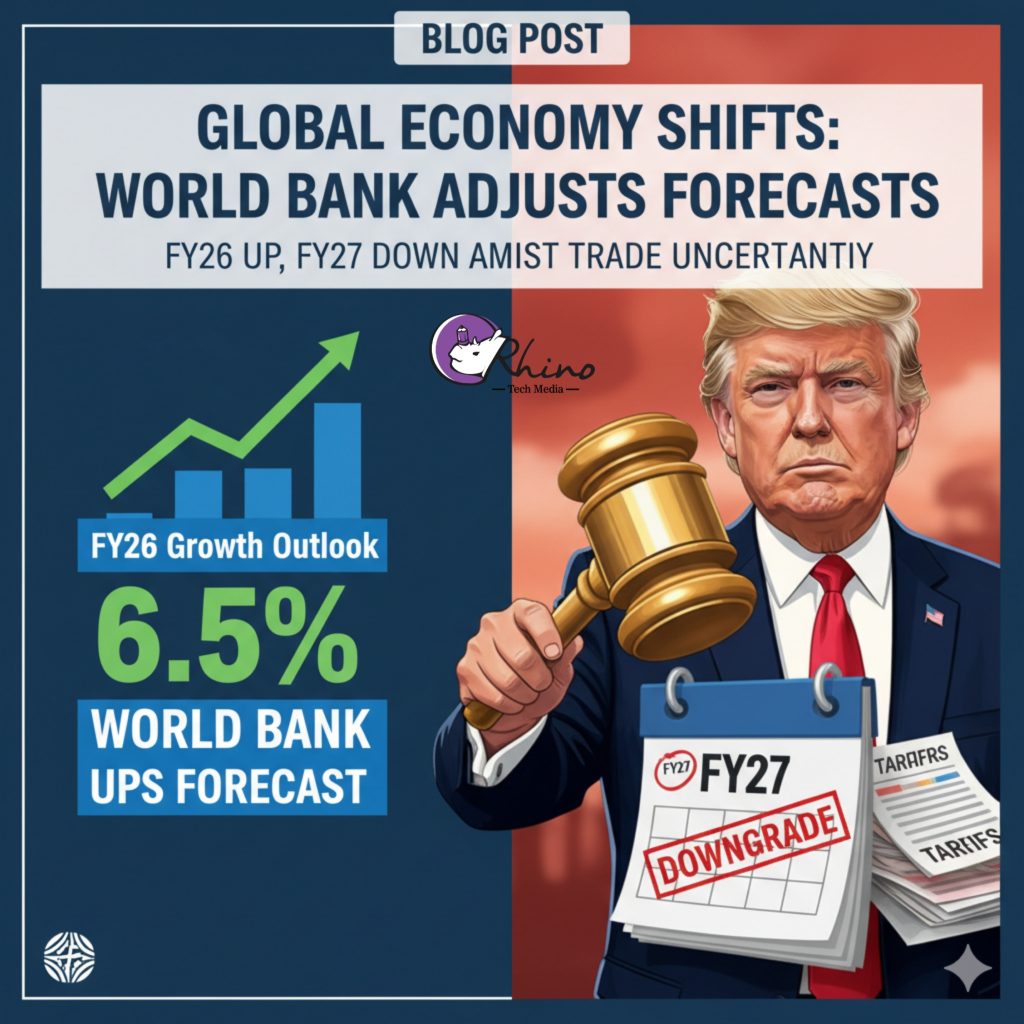Introduction
In its latest South Asia Development Update,k the World Bank has revised India’s growth forecast upward for the fiscal year 2025-26 (FY26), while simultaneously issuing a cautionary adjustment for the following year (FY27). The revision reflects confidence in India’s domestic momentum, yet also underscores the growing influence of external headwinds, especially protectionist trade policies instituted by the United States under President Donald Trump. This development highlights the delicate balance between domestic resilience and global risk in shaping macro forecasts for emerging markets.
The Revised Forecasts: Upside for FY26, Caution for FY27
The key changes announced by the Bank are as follows:
- The forecast for India’s economic growth in FY26 has been raised to 6.5 % from the earlier 6.3 %.
- Conversely, the projection for FY27 has been trimmed, lowered by about 0.2 percentage points to 6.3 %.
- For the broader region, the Bank expects South Asia’s growth to moderate: from an estimated 6.6 % in 2025 to 5.8 % in 2026.
Thus, while the near term looks stronger than previously assumed, medium-term caution is creeping in, largely due to external headwinds.
Drivers of the Upgrade for FY26
Several factors lend confidence to the upward revision for FY26:
- Stronger domestic performance than expected
The World Bank notes that India’s recent quarterly growth outpaced expectations, with robust performance in agriculture, rural income, and rural wage growth providing a supportive tailwind. - Stimulus from reforms and fiscal stimulus
Reforms in the Goods & Services Tax (GST) — including a reduction in the number of tax brackets and simplified compliance — are expected to bolster formal economic activity.
In addition, the fiscal authorities are leaning into public investment, especially infrastructure, to sustain growth. - Credit expansion and supportive monetary environment
Credit growth remains healthy, aiding private consumption and investment. The financing environment is relatively accommodative, helping underpin demand. - Resilience in consumption
Consumption remains a central pillar of the economy, buffered particularly by rural demand and wage growth in non-urban segments.
These elements collectively feed into a case for a more buoyant near-term growth trajectory.
Risks & Rationale Behind the FY27 Downgrade
While the short-term case is bullish, the World Bank is cautious about the horizon beyond FY26. Its decision to dial back FY27 expectations is largely driven by external risks, anchored on trade and policy uncertainty:
- U.S. tariffs and export impact
A central worry is the imposition of steeper U.S. tariffs on Indian exports. The Bank notes that about 50 % tariffs have been imposed on a large share of India’s goods exports to the U.S. — reportedly affecting ~75 % of such exports.
Since India directs nearly one-fifth of its exports to the U.S. (equivalent to ~2 % of GDP in 2024), the risk is nontrivial. - Trade headwinds undermining external demand
Rising protectionism globally is expected to dampen trade flows, which in turn would exert drag on export-oriented sectors.
The broader region (South Asia) is projected to slow because many of its economies are vulnerable to shifts in global demand and trade barriers. - Unwinding of stimulus and domestic constraints
The stronger momentum this year may partly reflect temporary factors — e.g. front-loaded investment, cyclical harvest gains, favorable rural wages. These are less likely to sustain indefinitely.
Moreover, capacity constraints, supply bottlenecks, and inflationary pressures could stymy extension of growth at the same pace. - Policy and external uncertainties
The risk that global conditions could worsen — due to recessionary pressures, commodity shocks, or further trade retaliation — adds downside risk. The Bank’s cautious stance signals recognition of these tail risks.
Broader Implications & Strategic Insights
This mixed revision carries several broader messages for policy makers, investors, and stakeholders:
- A strong foundation matters—but is not invincible
Even with stronger domestic dynamics, India’s growth remains susceptible to external pivots. Without stable trade rules and global demand, gains can easily be muted. - Diversification of markets becomes imperative
Overdependence on a few major export destinations (notably the U.S.) increases vulnerability. Exploring newer trade partners, expanding regional trade agreements, or boosting domestic value chains might help reduce exposure. - Focus on structural resilience
Enhancing productivity, supply chain robustness, and reducing friction in logistics and regulation will boost the economy’s capacity to absorb external shocks. - Policy signaling and confidence management
The upgrade to FY26 is itself a positive signal for markets, credit ratings, and investor confidence. But signaling clarity around policy and trade stance will matter strongly going forward. - Phased moderation is realistic
The adjustment in FY27 does not imply a collapse, but a more moderate, sustainable growth path. Policymakers should plan for that scenario rather than overshoot.
Conclusion
The World Bank’s updated projections present a nuanced narrative: for FY26, India’s growth outlook is stronger than before, driven by robust domestic demand, structural reforms, and resilient rural dynamics. Yet, the anticipation of U.S. trade protectionism and global trade frictions has led the Bank to temper its optimism for FY27. The dual message is clear — India has footing to run, but not without watching the winds of international policy and demand.

